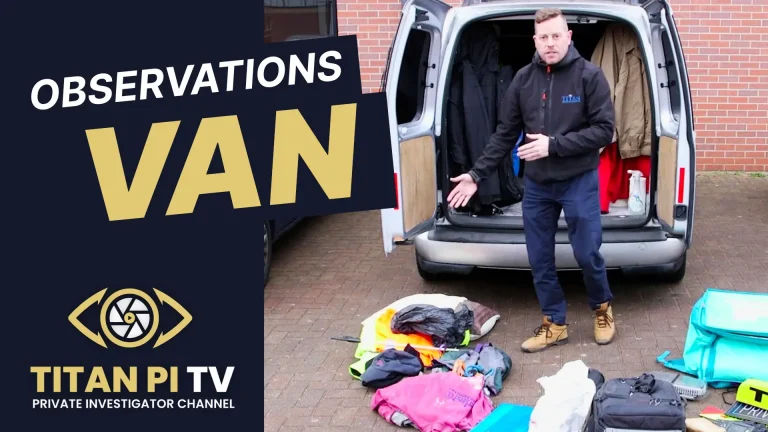What Kit Do You Need to Be a Surveillance Operative?
Essential Kit for Aspiring Surveillance Operatives: A Titan PI TV Guide
Titan PI TV’s latest episode takes viewers behind the scenes of a live, operational private investigation agency to answer a deceptively simple question: what kit do you actually need to be a surveillance operative? Hosted by Simon Henson, Managing Director of Titan Private Investigation Ltd, the episode delivers a practical, no-nonsense rundown of essential equipment, smart add-ons, and professional standards—drawn from Titan’s daily operational experience across England.
With ten offices from Truro in the South West up to Manchester in the North West, Titan delivers national coverage. That reach informs the guidance in this episode: this isn’t theoretical. It’s the real-world kit list used in professional surveillance, where legal compliance, quality of evidence and personal safety are all non-negotiables.
Training first: RQF Level 4 Covert Surveillance with a pathway to work
Before the kit list, Simon Henson grounds everything in training. Titan runs an Ofqual-regulated RQF Level 4 Covert Surveillance course—five intensive days at its Derby training facility. Over the past eight years, hundreds of learners have graduated. Upcoming dates include November and February, with further sessions typically released for May, September and November.
Where Titan differentiates itself from many providers is what happens after the course. Successful graduates are enrolled into the Titan Grow Student Aftercare Programme. It’s not merely mentoring; it’s a structured pathway into the industry that includes paid surveillance tasking at £30 per hour for a minimum of five hours. That crucial bridge from training to live operations underpins the episode’s kit advice: start with the essentials, buy quality where it matters, and add the enhancements as your operational tempo and earnings increase.
The minimum viable kit for professional surveillance
Simon distils the foundation kit into three elements:
- A camcorder
- A covert camera
- A suitable vehicle
Everything else is an efficiency booster. If you’re starting out, prioritise getting these three right.
1) The camcorder: your primary evidence tool
Your camcorder is your core evidential capture device for mobile and static surveillance. Simon showcases two Sony examples to illustrate the range:
- Entry-level: Sony CX-250
- Although no longer manufactured, refurbished or second-hand units are widely available.
- Strengths: Very usable in low light, straightforward to operate, and inexpensive.
- Typical cost: £100–£150.
- Verdict: An excellent starting point if you’re building out your kit on a budget without compromising the fundamentals.
- Premium: Sony AX-250
- A more advanced unit with superior image quality and features, albeit “getting old now”.
- Typical cost: £400–£600.
- Verdict: A workhorse choice for professionals who need robust, scalable performance and can justify the investment.
Simon’s overarching point is pragmatic: you don’t need to overspend to start working. What matters is stable, clear, evidentially sound imagery. If your camera is constantly shaking, you’re not producing a professional product.
2) The covert camera: blending in while recording
A covert camera is an everyday object adapted to capture audio and/or video discreetly. Used correctly and lawfully, it allows an operative to obtain critical close-in imagery in public settings without drawing attention.
Simon highlights two options available via Titan’s One Stop Kit Shop:
- Lawmate mobile phone
- Cost: £360 + VAT.
- Positioning: The “Rolls-Royce” option—credible as a normal device, high-quality capture, and purpose-built for covert operations.
- Best for: Operatives who need top-tier concealment and reliable performance in a range of environments.
- Key fob covert camera (Wi-Fi enabled recommended)
- Cost: £175 + VAT.
- Benefits: Entry-level pricing with the crucial ability to pair to your phone and view what’s being recorded. This ensures framing and context are correct without repeatedly handling the device.
- Best for: New operatives building a baseline kit who need functional covert capability at an accessible price point.
The practical advice: whichever model you choose, prioritise devices you can monitor in real time and easily operate under pressure.
3) The vehicle: your camera platform and mobile base
Your vehicle is more than transport—it’s your mobile observation post, your camera platform, and your deployment point for foot surveillance. Simon’s guidance is unequivocal:
- Choose a common, non-garish colour in a model widely seen on UK roads. Think invisibility through ubiquity.
- Fit legal window tints:
- You may only tint the two rear side windows and the rear windscreen.
- In the UK, you can go as dark as limousine tint on those rear panes.
- Do not alter the driver and front passenger windows beyond legal limits; compliance is essential.
- Maintain a clean, uncluttered interior that allows quick movement to the back seats and a clear line of sight for filming.
A “suitable vehicle” isn’t necessarily new or expensive. It’s about legality, discretion, and practicality.
Stabilisation and mounts: from “shaky” to “evidential”
Professionals deliver professional imagery. That means stable, clear footage that can stand up in a report—or a court bundle.
Simon demonstrates a headrest mount—one of the most versatile stabilisation options for in-vehicle filming:
- Headrest mount
- Mounts to the back of a front seat headrest.
- Lets you sit in the rear, out of sightlines, capturing steady imagery while waiting for a subject to depart or while conducting static surveillance.
- Cost: £69 + VAT.
- Stock: Available via Titan’s One Stop shop.
Because most mounts feature a standard threaded screw, Simon strongly recommends pairing mounts with quick release plates:
- Quick release plates (male/female set)
- One plate attaches to the mount; the other remains attached to your camera.
- Snap-in, snap-out operation allows instant repositioning without the faff of unscrewing hardware.
- Cost: £7.99 + VAT.
- Benefit: A small investment that saves time, reduces fumbles, and helps you stay discreet.
The operational payoff is significant. With a headrest mount and quick release, you can reposition swiftly, reduce camera shake, and capture more usable footage under pressure.
Optional but powerful: monitor and remote for safer, smarter filming
Once your core kit is in place, two upgrades can transform your workflow, especially when solo or when maintaining a low profile in a vehicle.
- 5.5″ external monitor (e.g., IYO)
- Connect via HDMI (standard-to-mini cable).
- Mirrors the camcorder’s screen, allowing you to view framing and focus without leaning over the camera.
- Practical scenarios:
- Sat in the front with your camera mounted behind on a headrest.
- Laid low in the back, out of sight, with a screen positioned near you.
- Moving on a follow while needing to capture “story” shots—e.g., “Subject exited at the M1, Junction 21”—to evidence the narrative of movement.
- Cost: ~£50 + VAT.
- Benefit: Discreet control and situational awareness, improving both safety and evidence quality.
- RM-VS1-style wired remote control
- Plugs into compatible camcorders and allows start/stop record, zoom in/out.
- Keep it near the gear stick/handbrake or on your lap to trigger recording without reaching back to the camera.
- Use cases:
- Solo mobile surveillance when brief, pertinent imagery is required while driving. (Caveat: always prioritise road safety.)
- Static surveillance from the back seat behind a visual barrier; monitor in one hand, remote in the other.
- Cost: £23.99 + VAT.
- Benefit: Reduces motion, keeps you concealed, and ensures you don’t miss key beats in the evidential story.
Both items are stocked by Titan’s One Stop Kit Shop at www.titansurveillancetraining.co.uk
Disguise and props: blending in to get closer, safely
Props can change how you’re perceived and how close you can get without arousing suspicion. Titan stocks a range designed for lawful, safe, and credible use:
- Magnetic vehicle signage
- “Motorway maintenance” or light works-style magnets.
- Uber-style magnetic taxi signs; optional roof light for additional plausibility.
- Rationale: Transform your vehicle’s perceived purpose temporarily. Magnets go on and off quickly, adapting to the environment and tasking while keeping your underlying vehicle unchanged.
- Simple handheld props
- Example: a litter picker.
- Use case: Public open spaces where you need to get closer to capture interaction—such as infidelity investigations—without looking like you’re watching. A benign, purposeful activity lets you occupy space credibly while your covert camera does its work.
Simon’s principle here is operational storytelling. Surveillance work is about telling the client what happened, with reliable visual evidence. If a subject meets a third party in a park, you must obtain clear imagery of both together. Props give you the proximity or the cover you need to do that safely and convincingly.
Professional standards: legality, stability, and narrative
Several operational principles recur throughout the episode:
- Stay legal
- Window tinting rules are strict in the UK: only the rear quarter windows and rear windscreen can be dark tinted to limousine-level. Front side windows must remain within legal light transmission limits.
- Always consider privacy and data protection law when capturing imagery and audio. Operate in public places or with appropriate legal grounds.
- Stability equals credibility
- Shaky footage looks amateurish and is less persuasive. Stabilised imagery via mounts and good camera technique makes your product stand up to scrutiny.
- Tell the evidential story
- Think in narratives: entrances and exits, meeting locations, route markers, junction numbers, time-stamped transitions. Short establishing clips—“Subject took the M1 Northbound, exited J21”—add powerful context to reports and timelines.
- Don’t overbuy on day one
- Start with a solid camcorder, a covert camera you can monitor, and a suitable vehicle. Add mounts, plates, monitors, remotes, and props as your assignments demand and your budget allows.
Budgeting your starter kit
For those planning their initial outlay, the episode’s indicative pricing provides a helpful framework:
- Camcorder:
- Entry-level (used/refurb): £100–£150
- Premium: £400–£600
- Covert camera:
- Key fob (Wi-Fi recommended): £175 + VAT
- Lawmate mobile phone: £360 + VAT
- In-vehicle stabilisation:
- Headrest mount: £69 + VAT
- Quick release plates: £7.99 + VAT
- Control and monitoring (optional):
- 5.5″ monitor: ~£50 + VAT
- Wired remote control: £23.99 + VAT
- Props and vehicle disguise:
- Magnetic signage, taxi signs, roof lights, handheld props: various pricing through Titan’s Kit Shop
Even at the entry tier—say, a £150 camcorder plus a £175 covert camera (both ex VAT)—you’re operationally viable. Add a headrest mount and quick release plate and you elevate your output with minimal extra spend.
Where to buy
Titan stocks the equipment demonstrated, along with a range of props and accessories, via the Titan One Stop Kit Shop at www.titaninvestigations.co.uk. Navigate to “Kit Shop” and select categories such as “Covert Cameras” or mounts and accessories.
As Simon notes, Titan currently has strong stock levels across the items featured—including headrest mounts, quick release plates, monitors and remotes—making it straightforward for new operatives to assemble a kit quickly and reliably.
Graduating to operations: from course to casework
The episode implicitly underscores an advantage of training with an active investigations agency: your kit choices are guided by live operational realities, not just classroom doctrine. Titan’s aftercare programme connects new operatives with real assignments, giving them the chance to apply technique, refine equipment choices, and invest incrementally.
As you build experience, you’ll learn which add-ons are indispensable for your style of work. Many operatives find that a headrest mount and quick release system become near-permanent fixtures; others swear by a monitor-and-remote pairing for long static observations with low visibility. Over time, props become a curated toolkit for different environments—retail parks, residential streets, corporate campuses, public spaces—each requiring its own flavour of plausible presence.
Closing thoughts: keep it simple, keep it professional
Simon wraps the episode with a reminder that you don’t need a van full of gear to do high-quality surveillance work. Start with the basics done well:
- A reliable camcorder
- A properly chosen covert camera
- A discreet, legally compliant vehicle
Then, as budgets allow, layer in stabilisation, rapid-change hardware, and remote/monitoring capabilities to improve efficiency and safety. Above all, aim for professional, stable imagery that tells a clear, evidential story.
If you prefer to listen on the go, Titan PI TV is also available as a podcast—search for “Titan PI TV Podcast” on your usual platform. And to keep up with future episodes, subscribe to the channel and give the video a thumbs up.
Until next time, Happy Friday from Titan PI TV—and if you’re taking your first steps into the world of covert surveillance, start smart, stay legal, and let your kit work for you.
What’s Next on Titan PI TV?
Titan PI TV continues to grow steadily, with 2,969 subscribers and counting—a testament to the appetite for straight-talking guidance in a complex field. If you found Simon Henson’s insights useful, subscribe to the channel to catch future episodes. New content drops every Friday at 3:00 pm, offering grounded advice for investigators, agency owners, and professionals who work with them.
Thank you for reading, watching, or listening to this week’s blog post on Titan PI TV. For more expert advice and behind-the-scenes insights, subscribe to Titan PI TV on YouTube or download the Titan PI TV podcast wherever you get your podcasts. If you found this information helpful, please give us a thumbs up and subscribe to our channel. Stay tuned for more insights into the world of private investigations. Until next time, stay safe and keep learning!
Titan PI TV: Uncovering the Truth, One Investigation at a Time.




















